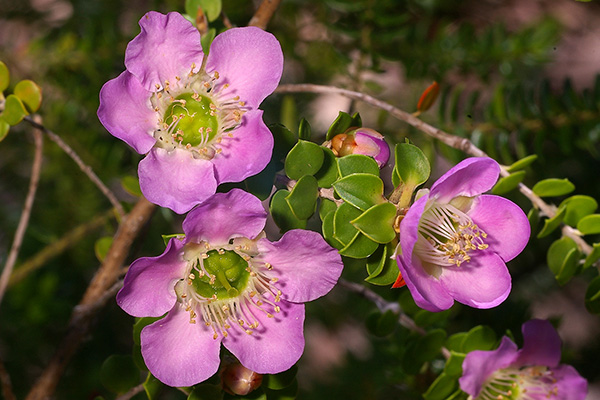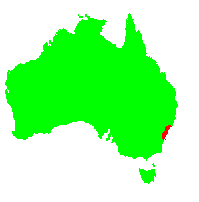General Description:
Leptospermum is a genus of about 83 species, all but three occurring in Australia. They are commonly known as ‘tea trees’ due to the practice of early European settlers of using the leaves of some species as a tea substitute. Leptospermum rotundifolium was originally named L.scoparium var. rotundifolium by Forster and Forster but renamed L.rotundifolium by (Maiden and Betche) F. Rodway ex Cheel in 1919.
Leptospermum rotundifolium is a shrub ranging in height from less than 1 metre to more than 2 metres with close, eventually gnarled, bark. Young stems carry a dense pubescence of short hairs with a short spreading pubescence persisting on older branches. Leaves are mostly 4 – 7 mm long with similar width , generally rounded but sometimes longer than the width. Leaves are usually glossy on the upper surface and sometimes carry a small point at the tip. Flowers, which are produced in late spring, are generally pink but occasionally white, up to 30 mm in diameter, and produced singly on modified shoots at the ends of axillary branchlets.
This plant performs best in temperate areas and although it grows quite well in subtropical regions, it does not flower to best advantage in these areas. However, it has been known to flower well in Brisbane in a sunny well-drained situation. Dark pink flowered forms are to be preferred and to ensure these are true to type it is best to grow them from cuttings from a known good plant. In general this species retains quite good shape and requires little pruning. This species is resistant to frosts and to salt spray. It is best grown in a well-drained, sunny site and provided with ample water during dry periods.
Two cultivars of the species have been recognised and are available through the nursery trade. These are:
- Leptospermum rotundifolium ‘Julie Ann’. This is a prostrate form from the Jervis Bay area of New South Wales which grows to a height of 0. 3 metres with a spread of up to 1. 5 metres. Pale pink flowers are often seen in autumn with flowering continuing through to late winter. Because of the dense foliage produced this cultivar makes a good ground cover.
- Leptospermum rotundifolium ‘Lavender Queen’. This cultivar is said to produce larger and deeper coloured flowers than that of the parent species. It is reputed to grow to a height of about 1.5 metres. It is assumed that cultivation requirements for this cultivar are similar to those required by the parent species.
L.rotundifolium is also one of the parents of the hybrid Leptospermum ‘Rhiannon’.
L.rotundifolium can be propagated easily from seed or from cuttings of medium hard wood which will strike fairly easily. Named cultivars should only be propagated from cuttings as seedlings may vary significantly from the parent plants.

Leptospermum rotundifolium
Photo: Brian Walters
 Australian Native Plants Society (Australia)
Australian Native Plants Society (Australia)













